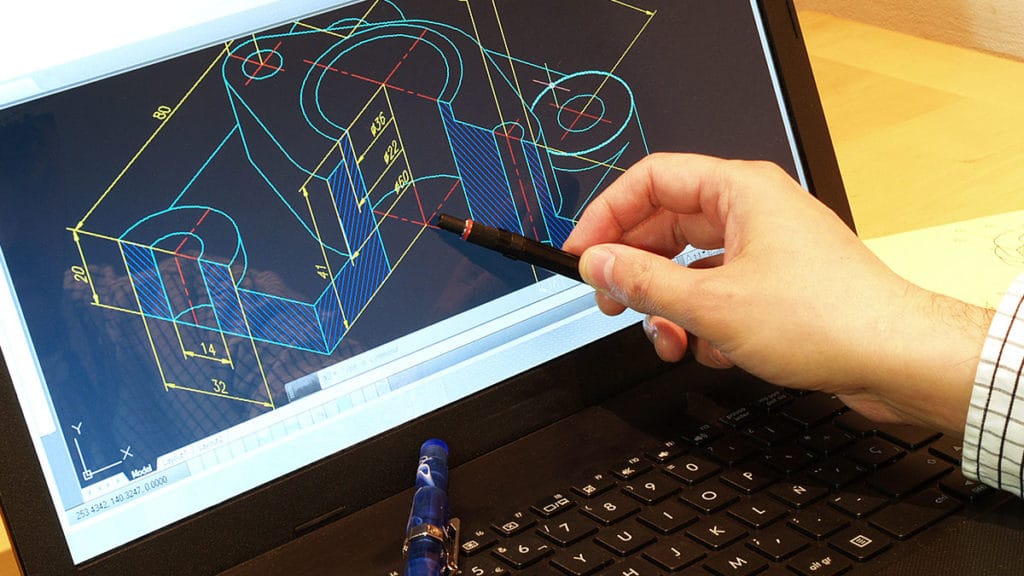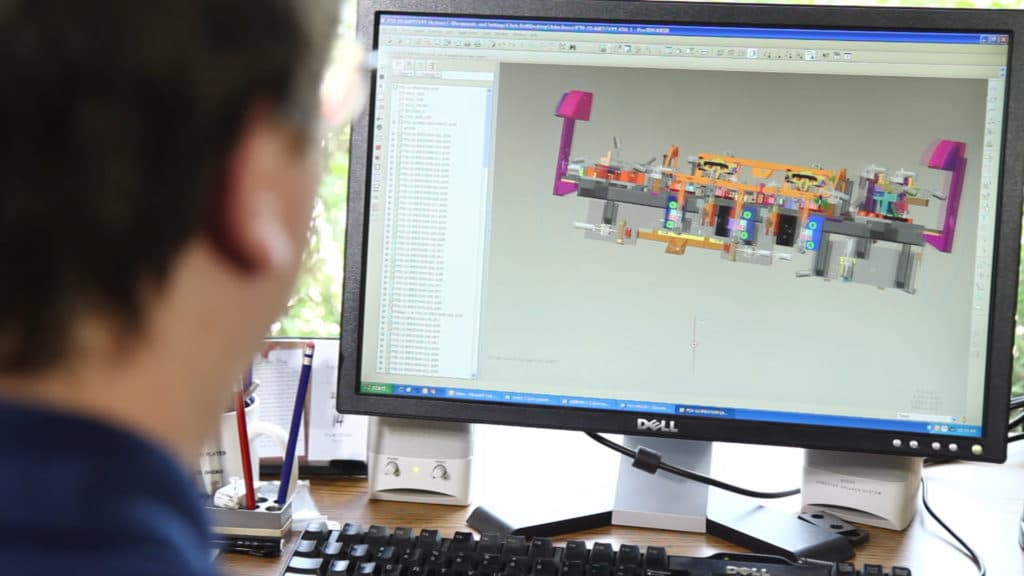Computer Aided Design (CAD) is integral and indispensable to a variety of industries, from engineering to design to architecture. The importance placed upon CAD means that CAD skills are increasingly necessary to open doors to prospective jobs. From CAD drafters to CAD engineers, there’s a wide selection of CAD jobs on offer. But what kind of CAD salaries are available? And what skills are needed to get the highest wage possible?
Find out with Scan2CAD’s exclusive guide to everything you need to know about CAD salaries. From the types of CAD jobs available, and the factors that impact your salary, to where you can find these jobs, we’ll provide you with all the essential statistics and information. Read on to find the right path for you.
Table of Contents
- CAD Salaries & Jobs: Overview
- Factors Impacting CAD Salaries
- CAD Careers and Salaries
- Career Advancement
- Essential Information Summary
- Pros & Cons
- Where to find CAD jobs
- Conclusion
CAD Salaries & Jobs: Overview
CAD salaries, like any other job salaries, are complicated. Firstly, your salary depends on which field you’re based in—whether it’s engineering, designing or drafting. The salaries for these jobs can then vary dramatically depending on further factors. How big is the company you’re looking to work for? Where is the job located? What is your skill set?
We’re going to look at the qualifications and skills you’ll need for jobs in five career sectors: CAD drafters, CAD technicians, CAD designers, CAD engineers and architects. We’ll also look at the many factors that will impact upon your prospective salary. But first, we’ll give you some general salaries that you might expect in these fields.
- CAD Drafters: $50,000.
- CAD Technicians: between $50,000 and $60,000.
- CAD Designers: $60,000+.
- Architects: $70,000+.
- CAD Engineers: between $80,000 and $90,000.
Of course, these salaries vary dramatically depending on your chosen area of expertise. For precise figures, check out our CAD Careers and Salaries section.
Factors Impacting CAD Salaries

As with any other job you would apply for, CAD job salaries can vary depending on many factors. Whether it’s your level of experience, your qualifications or even your location—all have an impact on your current or prospective CAD salary.
1. Qualifications
There are many qualifications and skills that can be required for CAD careers. We’re going to break them down into 3 main categories: education, licenses and internships.
Education
Typically, drafters and technicians require an associate’s degree for entry-level positions. This is a 2-year degree which can be undertaken at any technical institute. There are advantages to completing this degree—it’s cost-effective, it doesn’t take as much time as other degrees, and it can help you get your grades up if you want to pursue a bachelor’s degree.
If you want to become a CAD designer or an engineer, you will need to complete a bachelor’s degree. This degree typically takes between 4 to 5 years of study, which can be completed at colleges or online schools. Many people opt for this degree type, as it can boost earning potential, and is, more often than not, the first required step for many careers.
If you’re looking to up your earning potential and reach for managerial or supervisory positions, you may need to obtain a master’s degree. This degree is pursued after a bachelor’s degree, and is completed in 2 years. Many people opt for this degree as it can highlight expertise in a particular field. While it isn’t a compulsory step, it is advised for candidates who want to pursue higher salaries.
Licenses
Most CAD sectors will either require employees to obtain a license, or will at the very least push employees towards it. These licenses are ways to highlight your competence in your chosen field—which is appealing to potential employers. In fact, some CAD jobs will require you to complete a license in order to move up to a managerial position. We’ll take a look at the general ones you can expect below.
CAD drafters can receive certification from the American Design Drafting Association (ADDA). While it isn’t mandatory, it is recommended as it can demonstrate a high level of competence and knowledge of drafting standards. This can be offered in different specialities including architectural, civil and mechanical drafting.
CAD engineers don’t necessarily need a license for entry-level positions, but managerial positions will require one. The Professional Engineering (PE) license allows engineers higher levels of leadership and independence. Licensed engineers are called Professional Engineers (PEs) who can then oversee the work of other engineers and sign off on projects.
Architects are required to sit for the Architect Registration Examination (ARE) alongside voluntary certification from NCARB.
Some designers, such as interior designers, are also required to pass state-approved exams like the NCIDQ.
You will need to research carefully into what types of licenses your particular field requires you to have—after all, it could be the difference between an entry-level position and a supervisory position.
Internships
Experience is vital to any career you pursue—especially CAD careers. While most CAD careers like drafters or designers don’t necessarily require internships, they can prove useful for building up a portfolio and overall experience. For other careers, such as architecture, internships are a necessity. Architects have to complete 3 years in a paid internship—and that’s before they even can sit the ARE exam.
Whether your CAD career lists internships as a necessity or not, you should seriously consider it. One year—or even one month—can set you apart from your contenders: exactly what you need to stand out in a competitive field.
If you’re not sure where to start with internships, don’t worry—Scan2CAD has you covered.
Listed below are 5 resources that you can use to find internships in your relevant field. Simply type in your keywords (e.g. “mechanical engineer“) and you will be able to look through the wide variety of relevant internships available. Don’t forget to filter according to location or paid/unpaid internships.
2. Experience
Experience can have a huge impact on your CAD salary—and by experience, we mean experience in a relevant job. The longer you work in a field, the more skills and experience you pick up—making you more appealing to potential employers. As such, entry-level employees can expect a much lower salary when compared to mid-career (5-10 years) or experienced (10-20 years) employees.
To give you a rough idea, we’ve listed the difference in salary between entry-level employees and experienced, by broad CAD sectors. Please note that these statistics by Payscale are based upon a small sample of respondents—for our purposes, they’re only a guideline intended to highlight just how much experience can affect your salary.
| Length of Career | CAD Drafters | CAD Technicians | CAD Designers | CAD Engineers |
| Late-Career (20 years+) | ||||
|
Experienced (10-20 years) |
|
|
|
|
| Mid-Career (5-10 years) | ||||
| National Average | $40,000 | $40,000 | $48,000 | $56,000 |
| Entry-Level (0-5 years) |
Source: PayScale
As you can see, your level of experience can have a huge impact on your overall salary. Typically, the more experience you have, the more your salary is likely to increase.
3. Location & Industry
Experience isn’t the only factor that can affect your salary. Your location and your chosen industry will also have a huge impact. Some states offer higher salaries than others, with Alaska, for example, offering some of the highest in the nation. It’s also worth noting that some job sectors also offer higher salaries, such as Metal Ore Mining.
In addition, job growth will also depend on which particular industry sector you work in. Many of the jobs involved in manufacturing will see a decline in job growth—resulting in some employees being laid off. In fact, many CAD careers will be tied to the economy, so when there’s an economic recession of any kind, these jobs will feel the brunt of it.
If you’re interested in just how much location and industry can impact your salary, check out the section below!
CAD Careers & Salaries
And now the part you’ve all been waiting for—CAD careers and their specific salaries. Not only have we included summaries of the jobs, we’ve also added the projected job growth between 2014 and 2024, their median annual wage and the top paying state and industry!
CAD Drafters

Electrical/Electronics Drafter
Median Annual Wage: $59,520
Job Outlook: 5%
Top Paying State: Washington at $79,400
Top Paying Industry: Audio & Video Equipment Manufacturing at $80,760
Electrical/electronics drafters take the information provided by engineers and architects to create technical drawings of electrical wiring systems in power plants, communication hubs and so on. They also create drawings of wiring diagrams for the manufacturing, installation or repair of certain electrical equipment.
Employment is projected to grow 5%, which is fairly average for most occupations. There’s always need for continued work on the electrical system designs in buildings, cars and devices.
Mechanical Drafter
Median Annual Wage: $53,520
Job Outlook: -7%
Top Paying State: Washington at $73,450
Top Paying Industry: Pipeline Transportation of Natural Gas at $76,990
Mechanical drafters prepare technical drawings of machinery and other mechanical devices in industries such as manufacturing. Their diagrams will often include information such as dimension size, fastening methods and other engineering information. This work will often include long hours, due to the need for constant modifications.
There’s a projected decline in employment, possibly due to the fact that CAD software enables companies to do more than they could a decade ago—eliminating the need for some drafters.
Civil/Architectural Drafter
Median Annual Wage: $50,710
Job Outlook: -3%
Top Paying State: Alaska at $61,400
Top Paying Industry: Scientific Research & Development Services at $75,390
These drafters create drawings for construction purposes. A civil drafter will incorporate the terrain and topography of the building site, and an architectural drafter will show how the structure can integrate with the surrounding environment. This work will involve survey documentation, topographic maps and an understanding of the environment.
There’s a projected decline in employment of 3%; this could be due to the fact that many engineers and architects now look to CAD and BIM for drafting, as opposed to relying on drafters.
Technicians

Source: apnrecruitment.co.uk
Electrical/Electronics Engineering Technician
Median Annual Wage: $61,130
Job Outlook: -2%
Top Paying State: Alaska at $84,450
Top Paying Industry: Newspaper, Periodical, Book and Directory Publishers at $82,010
These technicians are responsible for electrical maintenance and assisting in the upkeep of electrical equipment. They also analyze circuits, wiring diagrams and drawings to install, repair or modify electronic systems or devices.
This position is in slight decline, which isn’t very surprising in traditional manufacturing industries. That being said, there is a slight demand in the computer systems design services for products involving GPS, for example.
Mechanical Engineering Technician
Median Annual Wage: $53,910
Job Growth: 2%
Top Paying State: Delaware at $69,610
Top Paying Industry: Pipeline Transportation of Crude Oil at $88,220
These technicians work with engineers to develop or improve products and machinery. They make the entire manufacturing process more efficient by improving upon existing processes. They analyze existing schematics, products and machinery, looking for ways to make them more efficient.
Job growth is slower than the average occupation growth—it’s predominantly projected to decline in manufacturing industries. Many firms hire outside consultants at a lower cost, than employing in-house technicians—thus eliminating many job prospects.
Civil Engineering Technician
Median Annual Wage: $49,260
Job Growth: 5%
Top Paying State: Alaska at $70,000
Top Paying Industry: Metal Ore Mining at $63,390
Civil engineering technicians are responsible for assisting civil engineers working on construction projects. Essentially, they’re an assistant who creates plans, surveys sites and inspects projects. Technicians handle the jobs that engineers don’t have the time for—from documentation and analytics, to cost estimates.
There’s a projected increase of 5% for employment, which is as fast as the average for all occupations. The need to repair, modify and create the country’s infrastructure will undoubtedly continue to increase.
Industrial Engineering Technician
Median Annual Wage: $53,780
Job Growth: -5%
Top Paying State: Alaska at $89,120
Top Paying Industry: Oil and Gas Extraction at $77,350
Industrial engineering technicians help industrial engineers implement designs. These designs will be used to make production as effective as possible—by analyzing production costs, preparing machinery layouts and planning workflows. Typically, these technicians will work in teams under the supervision of industrial engineers.
Employment is projected to decline 5%, due to the projected decline in manufacturing industries. Despite this, there will be a continued demand for cost control through increase efficiency.
Designers

Source: ahraycho
Industrial Designer
Median Annual Wage: $67,130
Job Growth: 2%
Top Paying State: Nevada at $78,680
Top Paying Industry: Support Activities for Mining at $95,270
Industrial designers create products and develop concepts for products that are manufactured at factories, such as toys, cars and home appliances. They combine art, business and engineering to make products that people use every day. In doing so, they have to take into consideration the functionality of the product, its aesthetics, usability and production costs.
Employment is set to grow 2%, which is slower than the average for all occupations. However, consumer demand for new products and styles will sustain the overall demand for industrial designers.
Fashion Designer
Median Annual Wage: $63,670
Job Growth: 3%
Top Paying State: Georgia at $87,960
Top Paying Industry: Motion Picture and Video Industries at $86,380
Fashion designers create designs for clothing, shoes, accessories, and other pieces. They sketch their concepts, select fabrics and give instructions as to how the product can be made. These designers need a strong knowledge of fabrics, and a portfolio demonstrating their overall skills.
Employment is projected to grow 3%, which is slower than average. There’s an overall decline in the apparel manufacturing industry, which impacts fashion designers. Despite this, there’s still a growing need for fashion-inspired clothing for the mass market.
Interior Designer
Median Annual Wage: $48,840
Job Growth: 4%
Top Paying State: District of Columbia at $86,410
Top Paying Industry: Activities Related to Real Estate at $78,530
Interior designers make interior spaces—such as homes or offices—functional, safe and aesthetically pleasing. They select decorative items, including colors and materials, to enhance the living or working environment. They are also required to have a knowledge of building codes and inspection regulations, in addition to universal accessibility standards.
Employment is projected to grow 4%, due to the constant need for structures to meet certain conditions. There’s always a need for interior design, particularly in long-term projects.
Architects

Architect
Median Annual Wage: $76,100
Job Growth: 7%
Top Paying State: California at $97,880
Top Paying Industry: Lessors of Real Estate at $114,430
Architects plan and design structures—everything from homes and offices to airports and factories. They are responsible for working with clients to draw and draft the design of their desired structure. Their designs are in-depth and include accurate specifications such as dimensions and materials.
Employment is projected to grow 7% which is about as fast as the average for all occupations. This isn’t surprising, as there’s a constant need for new structures, with an increasing emphasis on creating sustainable buildings. The use of CADD and BIM also gives architects the ability to do more without the help of drafters.
Engineers

Electrical/Electronics Engineer
Median Annual Wage: $93,010
Job Growth: 0%
Top Paying State: California at $115,960
Top Paying Industry: Oil and Gas Extraction at $129,630
Electrical engineers design, develop, test and supervise the manufacturing of electrical equipment. Electronics engineers design and develop electronic equipment such as communications systems. They look at ways to improve products by designing new ways to use electrical power. They also need to ensure that products that they are manufacturing or installing meet specifications and codes.
Employment is projected to show little to no change. This is due to the slow growth or decline in most manufacturing sectors. Research and development sectors will continue to show growth, however, with the constant need to look to improve the ways we use electricity.
Mechanical Engineer
Median Annual Wage: $83,590
Job Growth: 5%
Top Paying State: Alaska at $130,420
Top Paying Industry: Oil and Gas Extraction at $146,740
Mechanical engineers research, design, develop and test mechanical devices. They design devices and processes to solve practical problems. They research designs and make recommendations based on industry standards, regulations and customer needs. These engineers also test their prototypes—analyzing the results and making changes where required.
There’s a projected increase of 5% in employment, which is about as fast as the average for all occupations. Mechanical engineers have an advantage, as they can enter most sectors and are able to work on a variety of projects.
Civil Engineer
Median Annual Wage: $82,220
Job Growth: 8%
Top Paying State: Alaska at $110,050
Top Paying Industry: Oil and Gas Extraction at $130,750
Civil engineers design, build and supervise construction projects and systems in the public and private sector. These can range from small-scale projects, like road repairs, to large-scale projects such as airports. These engineers can work in different sectors, including the structural, environmental and transportation sectors.
There’s a projected increase of 8% in employment, which is as fast as the average of all occupations. Infrastructure ages, so there’s always a constant need to modify and improve upon it—civil engineers are a vital part in all of this work.
Industrial Engineer
Median Annual Wage: $83,470
Job Growth: 1%
Top Paying State: Alaska at $117,960
Top Paying Industry: Other Pipeline Transportation at $128,490
Industrial engineers look for ways to eliminate wastefulness in all production processes, including machinery, processes and workers. They seek to increase efficiency by working on improvement strategies involving worker training, scheduling changes and maintenance on existing hardware. These engineers also determine the quality or reliability requirements of the product in production.
Employment is projected to show little to no change. Industrial engineers are versatile, and can work in a wide variety of sectors—which is a huge advantage. However, this position is impacted upon by the overall decline in many manufacturing sectors.
Career Advancement

In any job sector, there’s always the possibility of career advancement. Although the next career step will vary depending on your field, it will generally be a managerial or supervisory position. Here are a few example career steps:
- Senior mechanical designer
- Project manager
- CAD manager
- Senior drafter
- Drafting supervisor
As with any other job, career advancement to these types of jobs will require more experience. For example, engineering managers need to have had experience with working under the guidance of a more experienced engineer. In addition, the ‘candidate’ would have to obtain a PE license, because only licensed engineers can assume particular responsibilities. The salaries from these types of jobs can range from $60,000 up to $90,000 and over.
In fact, an Engineering Manager for example, has a median annual wage of $132,800—that’s around $50,000 more than the annual wage for CAD engineers!
So if you’re looking to earn the big bucks, career advancement is the way forward. You can make the process to advancement easier by improving your experience and skills—thus making you stand out to your employers or potential employers. A bachelor’s or master’s degree would highlight your expertise within your chosen field, and a license catered to your field would also open many doors. Whilst further education like a master’s degree might be costly, it will pay off in the long run.
Essential Information Summary
If you’re only interested in the facts and figures—check out our handy table below. This summarizes all of the essential statistics and information that you might want to know about CAD salaries. From median annual wages to required education, the highest paying state and industry, and even projected job growth for the next 10 years, we’ve got all the information you need.
| Career | Median Annual Wage | Required Education (Entry-Level) | Highest Paying State | Highest Paying Industry | Job Growth 2014-2024 (%) |
| Electrical/Electronics Drafter | $59,520 | Associate’s Degree | Washington $79,400 | Audio & Video Equipment Manufacturing $80,760 | 5% |
| Mechanical Drafter | $53,520 | Associate’s Degree | Washington $73,450 | Pipeline Transportation of Natural Gas $76,990 | -7% |
| Civil/Architectural Drafter | $50,710 | Associate’s Degree | Alaska $61,400 |
Scientific Research & Development Services $75,390 | -3% |
| Electrical/Electronics Engineering Technician | $61,130 | Associate’s Degree | Alaska $84,450 |
Newpaper Directory Publishers $82,010 | -2% |
| Mechanical Engineering Technician | $53,910 | Associate’s Degree | Delaware $69,610 |
Pipeline Transportation of Crude Oil $88,220 | 2% |
| Civil Engineering Technician | $49,260 | Associate’s Degree | Alaska $70,000 |
Metal Ore Mining $63,390 | 5% |
| Industrial Engineering Technician | $53,780 | Associate’s Degree | Alaska $89,120 |
Oil and Gas Extraction $77,350 | -5% |
| Industrial Designer | $67,130 | Bachelor’s Degree | Nevada $78,680 |
Support Activities for Mining $95,270 | 2% |
| Fashion Designer | $63,670 | Bachelor’s Degree | Georgia $87,960 |
Motion Picture & Video Industries $86,380 | 3% |
| Interior Designer | $48,840 | Bachelor’s Degree | District of Columbia $86,410 |
Activities Related to Real Estate $78,530 |
4% |
| Architect | $76,100 | Bachelor’s Degree | California $97,880 |
Lessors of Real Estate $114,430 | 7% |
| Electrical Engineer | $93,010 | Bachelor’s Degree | California $115,960 |
Oil and Gas Extraction $129,630 | 0% |
| Mechanical Engineer | $83,590 | Bachelor’s Degree | Alaska $130,420 |
Oil and Gas Extraction $146,740 | 5% |
| Civil Engineer | $82,220 | Bachelor’s Degree | Alaska $110,050 |
Oil and Gas Extraction $130,750 | 8% |
| Industrial Engineer | $83,470 | Bachelor’s Degree | Alaska $117,960 | Other Pipeline Transportation $128,490 |
1% |
Source: Bureau of Labor Statistics
Pros & Cons
Thinking of taking a career in CAD? Want to know if it’s worth your time? Check out the pros and cons below…
Pros





Cons




If you’re really interested in CAD salaries, and are looking for ways to increase yours—you should seriously consider these pros and cons. It can take a long time to increase your salary, and ultimately it’s all down to how much work you’re willing to put in and whether the job really is the right fit for you. As always, research is key.
Where to Find CAD Jobs

If you’re not sure where to start the search for your new CAD job, don’t worry—we’ve got you covered. As with any other job search, you just need to take a look at the many job databases available. Here’s a list of some top job sites to get you started:
Just choose your relevant keywords like ‘Mechanical Engineer‘ and narrow down your search by location and salary—and start hunting for your perfect position!
Alternatively, if you’re interested in one-off projects or freelance work, you can check out these sites below. They work in the same way as generic job sites—just sign up, set up a profile and apply for the freelance work that people have posted.
If you’re looking for ways to increase your chances of success, here are a few extra tips:
- Stay up to date on the latest software. To increase your chances of success, you should keep an eye on software trends. You might find a job role that is perfect for you, only to find that they work with SolidWorks—which you don’t use. Sharpen your skills—it will help you in the long run.
- Only apply for internships and jobs that are relevant to you. It’s tempting to apply for anything that comes your way, but this will just waste your time. Only apply for jobs that are fitted to your skills and qualifications.
- Look for ways to improve. Whether it’s getting a license, or continuing your education with a master’s degree, there are always ways to improve your overall appeal to potential employers.
- Check out relevant blogs. Computer Aided Design is constantly changing, so you need to stay on top of news and trends. Scan2CAD’s news section, for example, covers the latest developments and announcements in the world of CAD.
Conclusion
No matter what field you’re interested in, it’s clear that there are many CAD options available. Whether it’s drafting, technical engineering, designing or architecture—there’s something for everyone. While they all differ a great deal in regards to future job growth, it is clear that CAD careers hold the potential for immense success.
Salaries will always vary—as we’ve shown, there are many factors involved. It can fluctuate depending on your industry sector, your location and your experience level. What is clear however, is that if you make the effort and go the extra mile, you can achieve an impressive salary.
While you might start out at an ‘unreasonable’ salary level, you need to remember that you have to work for that dream salary. Research is key—so make sure you’re aware of the steps you need to take to unlock your true earning potential.
Interested in more information surrounding CAD careers? Check out AutoCAD Careers—Everything You Need To Know. Alternatively, if you’re thinking of going freelance, take a look at Freelance CAD—Everything You Need To Know.




